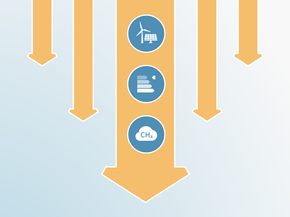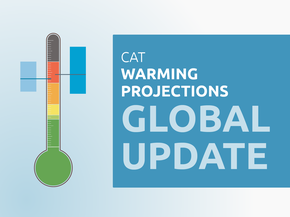Targets
Target Overview
In July 2021, Ethiopia submitted its updated NDC, committing to a 68.8% reduction below a revised business as usual (BAU) scenario conditional on international support (incl. LULUCF) (Federal Democratic Republic of Ethiopia, 2021). This target also includes an unconditional component – a 14% reduction below BAU – which Ethiopia will undertake with its own resources. Ethiopia intends to achieve both of these targets primarily through reductions in its land sector emissions. The CAT rates Ethiopia’s unconditional target as “1.5°C compatible” when compared to its fair share contribution and its conditional target as “Critically Insufficient” when compared to modelled domestic pathways.
Ethiopia has advanced its climate policy by publishing a Long-Term Low Emissions Development Strategy (LT-LEDS) in 2023 (The Federal Democratic Republic of Ethiopia, 2023). The LT-LEDS has outlined long-term sustainable and resilient economy‑wide mitigation pathways aiming to reach net zero by 2050, but Ethiopia has not yet formally committed to a specific pathway.
| Ethiopia - Main climate targets |
|---|
| 2030 unconditional NDC target | |||
|---|---|---|---|
| Formulation of target in NDC | The unconditional pathway will result in absolute emission levels of 347.3 MtCO2e in 2030 equal to a 14% (-56 MtCO2e) reduction below BAU in 2030. (The 2021 NDC provides all emissions estimates using global warming potentials of the AR5). | ||
| Absolute emissions level in 2030 excl. LULUCF |
243 MtCO2e 100% above 2010 |
||
| Status | Submitted on 23 July 2021 | ||
| 2030 conditional NDC target | |||
|---|---|---|---|
| Formulation of target in NDC | The conditional pathway will result in absolute emission levels of 125.8 MtCO2e in 2030, equal to a 68.8% (-277.7 MtCO2e) reduction below BAU in 2030 | ||
| Absolute emissions level in 2030 excl. LULUCF |
215 MtCO2e [77% above 2010] |
||
| Status | Submitted on 23 July 2021 | ||
| Net zero & other long-term targets | |||
|---|---|---|---|
| Formulation of target | Intention to become carbon-neutral by 2050 | ||
| Absolute emissions level in 2050 excl. LULUCF | N/A* | ||
| Status | Submitted on 21 June 2023 | ||
NDC Updates
2030 NDC targets
The CAT rates Ethiopia’s conditional target as “Critically Insufficient” when compared to modelled domestic pathways and its unconditional target as “1.5°C compatible” when compared to its fair share contribution.
| COUNTRY- History of 2030 NDC updates | First NDC (2015) | 2021 NDC update |
|---|---|---|
| 1.5°C Paris Agreement compatible |
|
|
| Stronger target | N/A |
|
| Fixed/absolute target |
|
|
NDC Update
Ethiopia submitted an updated 2030 NDC in July 2021, building on an interim NDC update submitted in December 2020 (Federal Democratic Republic of Ethiopia, 2021).
Ethiopia commits to a 68.8% reduction below a revised business as usual (BAU) scenario, conditional on international support (incl. LULUCF). This target includes an unconditional component, a 14% reduction below BAU, which Ethiopia will undertake with its own resources. This is an improvement on Ethiopia’s 2015 Intended Nationally Determined Contribution (INDC), which did not include an unconditional component (FDRE, 2015).
The 2021 updated NDC includes a revision of the BAU scenario used as a reference for the mitigation targets. While the revised BAU emissions level in 2030 is projected to be only slightly higher than in the 2015 INDC, it anticipates much higher emissions from the land use, land-use change and forestry (LULUCF) sector in 2030. The updated 2021 NDC further indicates that the LULUCF sector would play a larger role in achieving the targeted emissions reductions than in the 2015 INDC. Ethiopia intends to achieve its conditional and unconditional targets primarily through reductions in its land sector emissions (around 85% of total reductions).
NDC Upr criteria for assessing increased ambition, Ethiopia’s updated NDC does not reflect increased ambition. Greater reliance on the land sector for emissions reductions often indicates weaker efforts in other key sectors like energy, industry, and agriculture. Given the shift of focus, we do not consider Ethiopia’s updated NDC an increase in ambition.
The unconditional target results in an emissions level of 243 MtCO2e in 2030 (excl. LULUCF), while the conditional target would limit emissions to 215 MtCO2e (see Assumptions section for details on how these figures were calculated).
| First NDC | 2021 NDC update | |
|---|---|---|
| Formulation of target in NDC |
Unconditional target: No unconditional target Conditional target: “Ethiopia intends to limit its net greenhouse gas (GHG) emissions in 2030 to 145 MtCO2e or lower. This would constitute a 255 MtCO2e reduction from the projected ‘business-as- usual’ (BAU) emissions in 2030 or a 64% reduction from the BAU scenario in 2030.” |
Unconditional target: The unconditional pathway will result in absolute emission levels of 318 MtCO2e in 2030, which represents a reduction below the BAU of 14% (-56 MtCO2e) in 2030. Conditional target: “The impact of further policy interventions proposed under the conditional pathway decreases absolute emission levels to 98 MtCO2e such that the combined impact of unconditional and conditional contributions represents a reduction of 68.8% (-277.7 MtCO2e) below the revised BAU emissions in 2030.” |
| Absolute emissions level in 2030 excl. LULUCF |
Unconditional target: Not applicable Conditional target: 53% above 2010 emissions by 2030 |
Unconditional target: 100% above 2010 emissions by 2030 Conditional target: 77% above 2010 emissions by 2030 |
| Emissions compared to 1990 and 2010 excl. LULUCF |
Unconditional target: 38% above 2010 emissions by 2030 Conditional target: 33% below 2010 emissions by 2030 |
Unconditional target: 28-35% above2010 emissions by 2030 Conditional target: 2% above to 15% below 2010 emissions by 2030 |
| CAT rating |
Overall rating: 1.5°C compatible |
Conditional NDC target against modelled domestic pathways: Critically sufficient Unconditional NDC target against fair share: 1.5°C compatible |
| Sector coverage | Agriculture (livestock and soil), Forestry, Transport, Electric Power, Industry (including mining) and Buildings (including Waste and Green Cities) | Economy-wide |
| Separate target for LULUCF | No | No |
| Gas coverage | CO2, CH4, N2O | CO2, CH4, N2O |
| Target type | Absolute emissions limit | Absolute emissions limit |
*Before September 2021, all CAT ratings were based exclusively on fair share and only assessed a country’s target
Analysis of earlier NDC developments:
CAT rating of targets
Developing countries like Ethiopia will need support to achieve emissions reductions in line with a modelled domestic pathway achieving the 1.5°C long-term temperature goal.
Ethiopia has put forward two targets in its NDC. One that it will achieving using its own resources and one that requires international support. We rate the country’s unconditional target compared to its fair share contribution and its conditional target compared to the level of reductions needed according to the modelled domestic pathways.
Developing countries like Ethiopia will need support to achieve emissions reductions in line with a modelled domestic pathway achieving the 1.5°C long-term temperature goal.
Ethiopia has put forward two targets in its NDC. One that it will achieving using its own resources and one that requires international support. We rate the country’s unconditional target compared to its fair share contribution and its conditional target compared to the level of reductions needed according to the modelled domestic pathways.
The “1.5°C compatible” rating indicates that Ethiopia’s Unconditional NDC target is consistent with its fair share of the global mitigation efforts to limit warming to 1.5°C. Ethiopia’s NDC unconditional target does not require other countries to make comparably deeper reductions or greater effort and is in the most stringent part of its fair share range.
Further information on how the CAT rates countries (against modelled domestic pathways and fair share) can be found here.
Net zero and other long-term target(s)
We evaluate the net zero target as: Average.
In June 2023, Ethiopia submitted a Long-term Low Emissions Development Strategy (LT-LEDS) for 2020-2050 (The Federal Democratic Republic of Ethiopia, 2023). The LT-LEDS outlines three pathways that could lead to net zero by 2050 or sooner, but Ethiopia has not yet formally committed to a specific pathway.
Ethiopia could further advance its net zero target’s transparency, target architecture, and scope by enshrining its net zero target in law, providing information on whether its targets cover international aviation and shipping, and communicate transparent assumptions on carbon dioxide removal pathways.
For the full analysis click here here.
Further analysis
Latest publications
Stay informed
Subscribe to our newsletter




